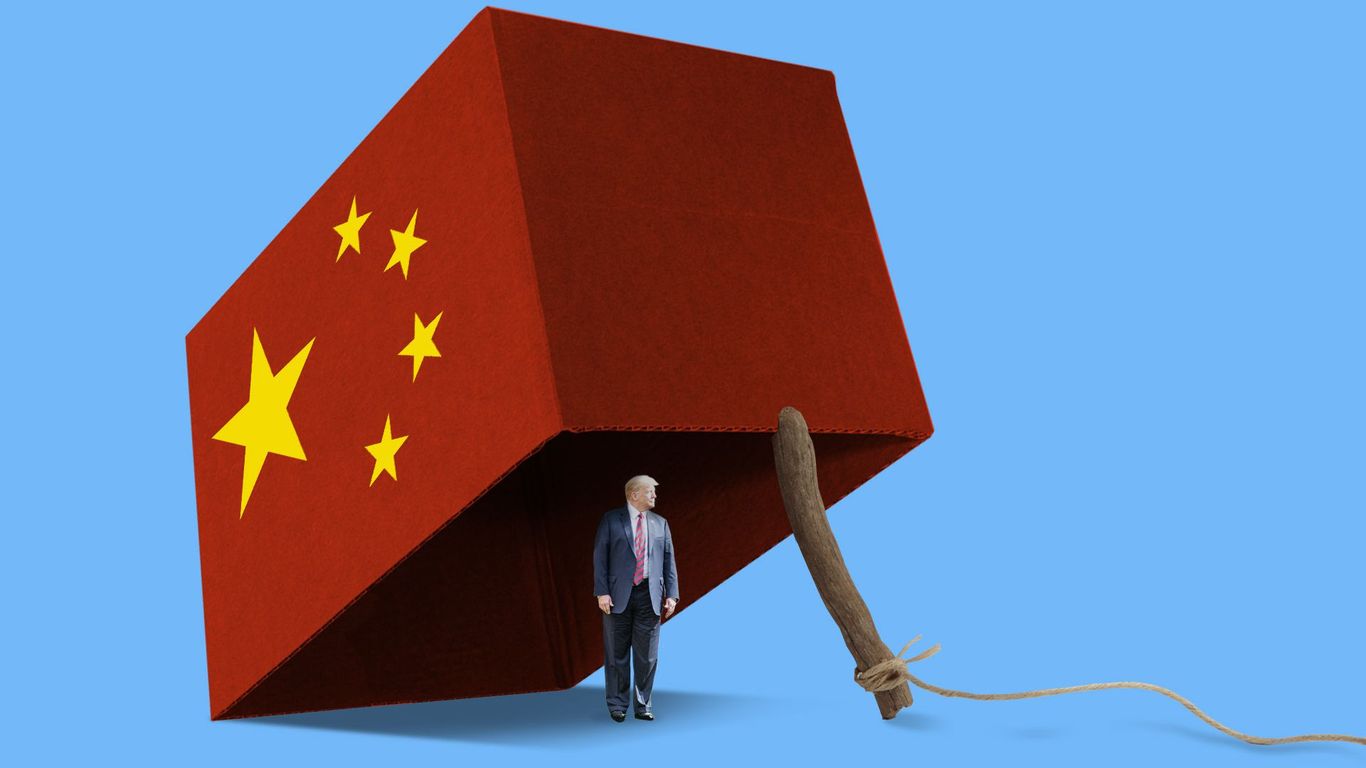Analyzing The Effects Of Trump's China Tariffs On US Consumers And Businesses

Table of Contents
Increased Prices for Consumers
The most immediate and widely felt consequence of Trump's China tariffs was a rise in prices for numerous consumer goods. This increase wasn't confined to a single sector; it impacted a broad range of products Americans rely on daily.
Impact on various consumer goods:
- Electronics: Tariffs on imported electronics, including smartphones, laptops, and televisions, led to noticeable price hikes. Studies showed increases ranging from 5% to 20% depending on the product and the extent of Chinese components.
- Clothing and Footwear: The apparel industry was significantly affected. The cost of clothing, shoes, and accessories increased, particularly for items heavily reliant on Chinese manufacturing.
- Furniture and Home Goods: Consumers experienced higher prices on furniture, home décor, and other household items imported from China.
- Toys and Games: The holiday season felt the impact, with higher prices on many popular toys and games.
The mechanism behind these price increases is straightforward: tariffs directly increased the cost of importing goods from China. These increased import costs were largely passed on to consumers in the form of higher prices at retail. Statistics from the Bureau of Labor Statistics (BLS) showed a clear correlation between the implementation of tariffs and increased inflation in various consumer goods categories, particularly in 2018 and 2019. This contributed to a squeeze on consumer purchasing power.
Shift in Consumer Spending Habits:
Facing higher prices, consumers responded in several ways.
- Reduced Spending: Many consumers cut back on discretionary spending, opting to delay purchases or forgo items altogether. This reduction in consumer spending had a dampening effect on overall economic growth.
- Shift to Alternative Products: Some consumers sought out alternative products, either domestically produced or imported from other countries. This shift created opportunities for some businesses, while others struggled to adapt.
- Search for Discounts and Deals: Consumers became more price-sensitive and actively sought discounts, sales, and alternative purchasing channels to mitigate the impact of higher prices.
The long-term effects on consumer purchasing power and economic growth remain a subject of ongoing debate and economic analysis. The changes in consumer behavior underscore the significant impact of trade policy on household budgets and the overall economy.
Impact on US Businesses
Trump's China tariffs had a profound and varied impact on US businesses, presenting both challenges and opportunities.
Challenges Faced by Importing Businesses:
Many US businesses heavily reliant on imported goods from China faced significant difficulties.
- Retailers: Retailers selling clothing, electronics, and other consumer goods faced increased costs and squeezed profit margins due to higher import prices.
- Manufacturers: Companies relying on Chinese-made components experienced disruptions to their supply chains and increased operational costs. This often resulted in delays, increased inventory costs, and a struggle to meet consumer demand.
- Small and Medium-Sized Enterprises (SMEs): SMEs, often lacking the resources of larger corporations, were particularly vulnerable to the added costs and complexities of navigating the changing trade landscape.
Businesses adapted in various ways, including raising prices to offset increased import costs, exploring alternative sourcing markets (often more expensive and less reliable), and in some cases, downsizing or even closing operations.
Opportunities for Domestic Businesses:
The tariffs did, however, create opportunities for some US businesses.
- Increased Market Share: Domestic companies producing goods competing with Chinese imports saw increased market share as consumers switched to domestically made alternatives.
- Potential Job Creation: Some US manufacturers experienced increased production and potentially created jobs to meet the growing demand for domestically produced goods.
While some sectors experienced growth, it's crucial to analyze whether this growth offset the negative impacts felt by other businesses. The overall net effect on US job creation and economic output due to Trump's China tariffs remains a topic of ongoing economic analysis and debate.
Unintended Consequences and Economic Effects
The imposition of Trump's China tariffs had several unintended consequences, including a broader impact on the global economy.
Retaliatory Tariffs from China:
China responded to the US tariffs with retaliatory tariffs on US exports, impacting various US industries.
- Agricultural Exports: US agricultural exports, such as soybeans and pork, were particularly hard hit by Chinese retaliatory tariffs. This led to decreased sales, lower farm incomes, and government support programs to mitigate losses.
- Manufacturing Exports: Other US manufacturing exports also faced higher tariffs in the Chinese market, creating additional challenges for US businesses.
This escalation of tariffs contributed to a trade war between the two economic giants, impacting global trade flows and uncertainty.
Overall Economic Impact:
The overall economic impact of Trump's China tariffs is a subject of ongoing debate and economic research.
- Inflation: As already mentioned, tariffs contributed to increased inflation, reducing consumer purchasing power and slowing economic growth.
- GDP Growth: The impact on GDP growth is complex, with studies showing both positive and negative effects depending on the sector and methodology employed.
- Job Creation/Loss: The net effect on job creation and loss is also unclear, with job gains in some sectors potentially offset by losses in others.
Numerous economic studies have attempted to quantify the overall economic impact, providing varied results and often emphasizing the uncertainty and complexities of disentangling the specific effects of the tariffs from other economic factors.
Conclusion
Trump's China tariffs had a complex and multifaceted impact on US consumers and businesses. Consumers faced increased prices on a wide range of goods, forcing shifts in spending habits and potentially hindering economic growth. While some domestic businesses benefited from increased market share and potential job creation, many import-reliant businesses struggled with increased costs and supply chain disruptions. Furthermore, retaliatory tariffs from China added another layer of complexity, contributing to a trade war and broader economic uncertainties. The overall economic impact is still under debate, with economists analyzing various metrics like inflation, GDP growth, and job creation/loss to understand the lasting consequences.
Understanding the lasting effects of Trump's China tariffs is crucial for informing future trade policy. Further research and analysis on the long-term consequences of these tariffs are vital to avoid similar economic disruptions. Continue exploring the intricacies of Trump's China tariffs and their ongoing impact on the US economy to ensure more informed and effective trade strategies in the future.

Featured Posts
-
 Nyt Spelling Bee April 3 2025 Clues Answers And Pangram
Apr 29, 2025
Nyt Spelling Bee April 3 2025 Clues Answers And Pangram
Apr 29, 2025 -
 Wo Arbeitet Carsten Jancker Jetzt Nach Leoben
Apr 29, 2025
Wo Arbeitet Carsten Jancker Jetzt Nach Leoben
Apr 29, 2025 -
 Donald Trump Advocates For Pete Rose Pardon And Hall Of Fame Inclusion
Apr 29, 2025
Donald Trump Advocates For Pete Rose Pardon And Hall Of Fame Inclusion
Apr 29, 2025 -
 Oh What A Beautiful World Willie Nelsons Latest Album Release
Apr 29, 2025
Oh What A Beautiful World Willie Nelsons Latest Album Release
Apr 29, 2025 -
 Nyt Strands Monday March 31 Complete Solutions For Game 393
Apr 29, 2025
Nyt Strands Monday March 31 Complete Solutions For Game 393
Apr 29, 2025
Latest Posts
-
 Future Of Mtv Movie And Tv Awards Uncertain After 2025 Cancellation
May 12, 2025
Future Of Mtv Movie And Tv Awards Uncertain After 2025 Cancellation
May 12, 2025 -
 The Challenge 41 Which Fan Favorite Was Eliminated
May 12, 2025
The Challenge 41 Which Fan Favorite Was Eliminated
May 12, 2025 -
 Mtv Cribs Comparing The Homes Of Todays Wealthy Youth To Past Generations
May 12, 2025
Mtv Cribs Comparing The Homes Of Todays Wealthy Youth To Past Generations
May 12, 2025 -
 Rich Kids Cribs A Tour Of Opulence And Excess On Mtv
May 12, 2025
Rich Kids Cribs A Tour Of Opulence And Excess On Mtv
May 12, 2025 -
 Ru Pauls Drag Race S17 E13 Preview A Family Affair Drag Baby Mamas
May 12, 2025
Ru Pauls Drag Race S17 E13 Preview A Family Affair Drag Baby Mamas
May 12, 2025
